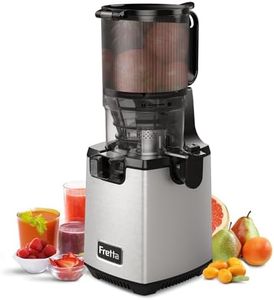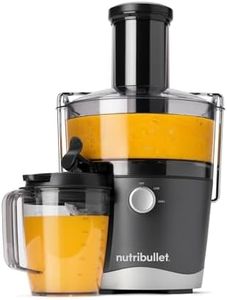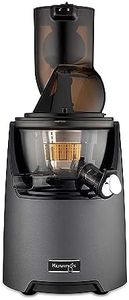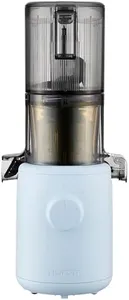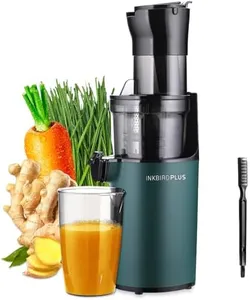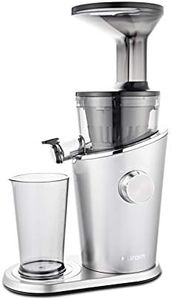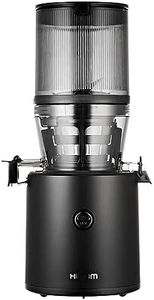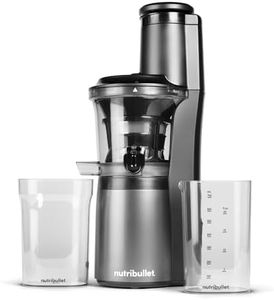We Use CookiesWe use cookies to enhance the security, performance,
functionality and for analytical and promotional activities. By continuing to browse this site you
are agreeing to our privacy policy
10 Best Slow Juicers
From leading brands and best sellers available on the web.Buying Guide for the Best Slow Juicers
Choosing a slow juicer can feel a bit overwhelming with so many options, but it's all about finding the one that matches your lifestyle and how you plan to use it. Slow juicers, also known as masticating juicers, work at lower speeds, which helps preserve more nutrients in your juice compared to high-speed juicers. Before you make a decision, think about the kinds of produce you want to juice, how much juice you want to make at once, how often you're likely to use it, and how much space you have in your kitchen. Understanding a few key specifications will help you narrow down your choices and pick the perfect juicer for your needs.Juicing Speed (RPM)RPM stands for 'revolutions per minute,' which tells you how fast the juicer's auger spins. In the context of slow juicers, a lower RPM means the juicer operates more slowly, generating less heat and reducing oxidation in your juice. This is important because less oxidation generally means your juice will stay fresh longer and keep more nutrients. Juicing speeds in slow juicers usually range from about 40 to 110 RPM. Lower speeds (closer to 40 RPM) are best for those who want maximum nutrition and plan to store juice for a day or two, while higher speeds (closer to 100 RPM) can get the job done faster but might sacrifice a bit of juice quality. Pick lower speeds if you're a health enthusiast looking for top nutrition, and consider slightly higher speeds if you’re looking for convenience and fast juicing.
Feed Chute SizeThe feed chute is where you place your fruits and vegetables in the juicer. A larger feed chute means you’ll spend less time prepping your ingredients, as you can fit bigger chunks or even whole produce inside. Small chutes require more cutting, which can add to your prep time. Chute sizes typically range from narrow (about 1.5 inches wide) to wide (about 3 inches or more). If you value quick preparation and less fuss, a wide feed chute is ideal. If you don’t mind chopping and have limited countertop space, a smaller chute is sufficient.
Juicer Type (Horizontal vs. Vertical)Slow juicers come mainly in horizontal and vertical layouts. Horizontal juicers usually handle leafy greens, wheatgrass, and tough veggies particularly well, making them ideal for those interested in juicing a variety of produce, especially greens. Vertical juicers are more compact and easier to fit on kitchen counters, typically offering faster juice extraction for soft fruits and vegetables with minimal effort. Choose horizontal styles if you want to juice greens often and maybe try nut butters or sorbets, and vertical models if you prioritize space-saving and mostly juice fruits and softer veggies.
Ease of CleaningCleaning your juicer is a key factor, especially if you plan to use it regularly. Some models come with lots of parts and nooks that can be difficult to clean, while others have designs that are easier to rinse and assemble. Look for features like dishwasher-safe components and included cleaning brushes. If you know you’ll get frustrated by a complicated cleanup, choose a simple design with fewer parts to clean. If you only plan to juice once in a while, cleaning complexity might not matter as much.
Juice Yield and Pulp DrynessJuice yield refers to how much juice is extracted from your fruits and vegetables, and pulp dryness tells you how much juice is left behind in the discarded pulp. Higher yield and drier pulp mean you’re getting more juice out of your produce, which is important if you juice in large quantities or want to get the most out of expensive fruits and veggies. Some models extract more juice due to better auger design and pressing power. If maximizing juice is your goal, pay attention to reviews and specs about juice yield and look for dry, crumbly pulp.
Noise LevelSlow juicers are generally quieter than fast juicers, but there can still be a difference in how much sound each model makes. If you're sensitive to noise or plan to juice early in the morning or late at night, look for information on decibel levels or user reviews that mention noise. For most users, all slow juicers will be reasonably quiet, but consider a model labeled as ultra-quiet if noise is a major concern for your household.



